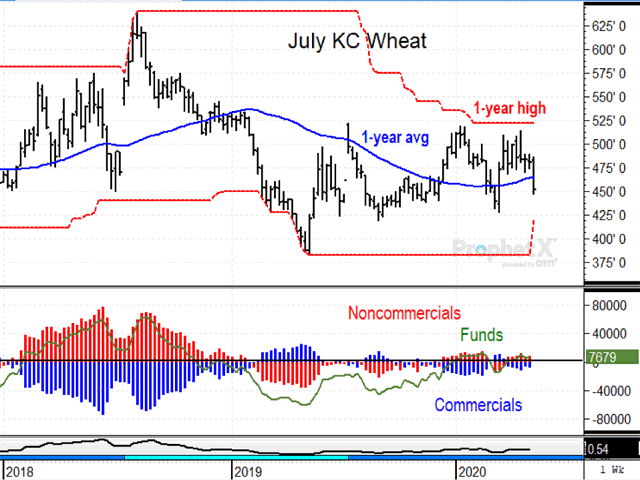Todd's Take
KC Wheat Turns Bearish Early in 2020
In last week's Todd's Take (https://www.dtnpf.com/…), I described the bullish potential in this year's spring wheat prices. In spite of Wednesday's 12 3/4-cent drop in July Minneapolis wheat, the bullish argument picked up more support in the past week after CFTC data showed futures funds now holding their largest bearish bet on record, 23,893 net shorts.
USDA also helped the cause in Tuesday's World Agricultural Supply and Demand Estimates (WASDE) report, lowering its estimate of ending hard red spring (HRS) wheat stocks from 250 million bushels (mb) to 243 mb or 41% of annual use. That is the lowest stocks-to-use ratio estimated in nearly two years and compares to 59% one year ago.
Spring wheat planting remains a challenge in North Dakota. Late Monday (Apr. 11), USDA said 27% of North Dakota's spring wheat crop was planted, less than half the normal pace for this time of year. One-third of the state is dealing with surplus moisture and Thursday's U.S. Drought Monitor showed abnormally dry condition in the western part of the state.
Spring wheat prices have not yet found a bullish trigger to disrupt the current bearish momentum, but prices have been reluctant to extend contract lows and the funds remain vulnerable to short-covering.
While Minneapolis wheat has been drifting to its lowest July prices in over three years, July Kansas City wheat prices enjoyed two rallies in its offseason. Prices rallied a dollar a bushel from early September 2019 to $5.19 in January, as a decent amount of U.S. export demand helped KC wheat shake off the bearishness of 2019's record high global wheat crop.
P[L1] D[0x0] M[300x250] OOP[F] ADUNIT[] T[]
I first described the sell-off from January's high on March 6 in "HRW Wheat Rally Comes to an End" ( https://www.dtnpf.com/… ).
As it turned out, KC wheat prices had one more bullish surprise in store. As corn prices were plummeting in response to coronavirus fears, flour millers helped boost wheat prices with aggressive buying to keep grocery shelves stocked as pandemic concerns ran high.
In mid-April, July KC wheat prices got an additional boost from a cold snap that damaged crops in central Kansas and surrounding areas. A gradual increase in dry conditions in Colorado and western Kansas also lended support.
Wheat's second rally added 75 cents to July KC prices in just over a month, but fell a nickel short of the January peak before turning lower. USDA's good to excellent rating for winter wheat went from a 10-year high of 62% before the cold snap to 53% as of May 10, but the bullish impact on prices faded.
On Wednesday, May 13, July KC wheat fell 15 cents to a new one-month low of $4.54 1/4. The weekly chart of July prices shows a classic technical example of a market that encountered resistance near its one-year high, left behind a lower high and closed below the one-year average for the first time in nine weeks. Not surprisingly, Wednesday's lower close turned the weekly stochastic lower as well.
To complete the bearish picture for KC wheat, Europe, Ukraine and southern Russia were all experiencing a stretch of dry weather until recent rains arrived to help crops. Southern Russia could still use more rain, but the threat perceived two weeks ago has eased for now.
Tuesday's WASDE report predicted another record high world wheat crop in 2020-21, and also predicted another 550 mb will be added to the ending global surplus. Europe's production is expected to be lower in 2020, but Australia's crop looks ready for a rebound after two years of drought.
It is too early to be confident about USDA's new-crop estimate, but we also have to admit there is no significant production threat to counter the bearish argument at this time. USDA's WASDE report estimates an average farm price of $4.60 a bushel for all wheat, but the current technical view suggests KC wheat prices are headed lower.
This week's sell-off is a significant bearish change in momentum for new-crop KC wheat prices and a reasonable technical target for the 2020 low in spot KC wheat would be somewhere near $4.00 a bushel.
I realize that is not welcome news for producers of hard red winter (HRW) wheat to hear. The bullish hope is that there is still plenty of time for adverse weather to disrupt the current bearish outlook. We are not seeing it yet, but we will continue to monitor the changing patterns of 2020.
Todd Hultman can be reached at Todd.Hultman@dtn.com
Follow him on Twitter @ToddHultman
(c) Copyright 2020 DTN, LLC. All rights reserved.




